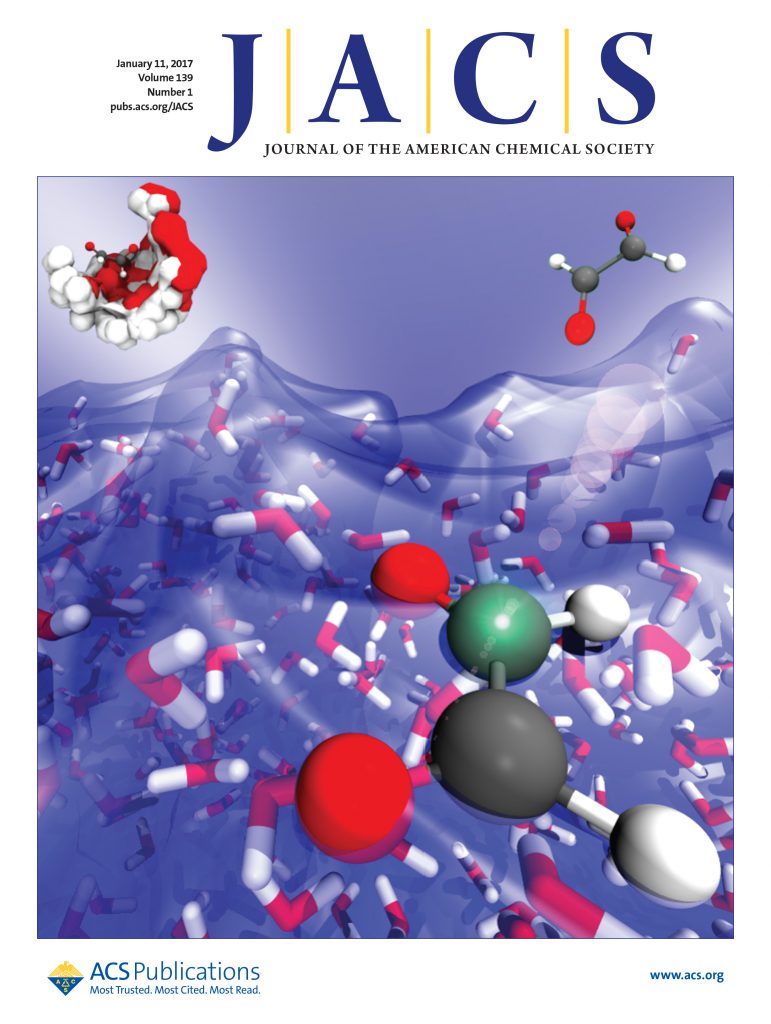一种罕见的微生物紫红质的多步11顺式到全反式视网膜光异构化。
IF 15.6
1区 化学
Q1 CHEMISTRY, MULTIDISCIPLINARY
引用次数: 0
摘要
视紫红质是一类广泛的视网膜结合光感受器。微生物紫红质通常通过全反式到13顺式的光异构被激活,而动物紫红质主要通过11顺式到全反式的光异构被激活。紫红质是一种特殊的微生物紫红质亚家族,具有双稳定的紫红质结构域,可以在远红色吸收态D661和绿色吸收态P540之间进行光转换。D661到P540的光化学反应涉及一种特殊的全反式到11顺式异构化,反之亦然。本文通过飞秒-亚毫秒瞬态吸收、飞秒受激拉曼光谱和闪光光解光谱测定了南极南极藻紫红质11-顺式全反式光反应。主要的光反应包括在240秒内从11-顺式反应物到高度扭曲的全反式和13-顺式光产物的混合物的超快异构化。然后,13-顺式部分在120ps内热异构化为扭曲的全反式RSB。我们提出了C11 = C12和C13 = C14双键协同的支化光异构的自行车踏板模型。一个反应物部分在C13 = C14双键处经历自行车踏板运动,导致全反式视网膜。另一部分经历了C11 = C12和C13 = C14的完整的自行车踏板运动,导致13-顺式视网膜。初级产物被捕获在基态位能表面,具有较低的能垒,有利于13-顺式视网膜在120ps内热异构化成全反式视网膜,全反式视网膜随后在结构和能量上弛缓,随后的时间常数分别为0.7和62 μs和4.4 ms,并伴有反离子质子化,完成P540到D661的光化学反应。本文章由计算机程序翻译,如有差异,请以英文原文为准。
Multistep 11-cis to All-trans Retinal Photoisomerization in Bestrhodopsin, an Unusual Microbial Rhodopsin.
Rhodopsins constitute a broad class of retinal-binding photoreceptors. Microbial rhodopsins are canonically activated through an all-trans to 13-cis photoisomerization, whereas animal rhodopsins are mostly activated through an 11-cis to all-trans isomerization. Bestrhodopsins constitute a special microbial rhodopsin subfamily, with bistable rhodopsin domains that can be photoswitched between a far red-absorbing state D661 and a green-absorbing state P540. Its photochemistry involves a peculiar all-trans to 11-cis isomerization for the D661 to P540 photoreaction and vice versa. Here, we present the P. antarctica bestrhodopsin 11-cis to all-trans photoreaction as determined by femtosecond-to-submillisecond transient absorption, femtosecond stimulated Raman and flash-photolysis spectroscopy. The primary photoreaction involves ultrafast isomerizations in 240 fs from the 11-cis reactant to a mixture of highly distorted all-trans and 13-cis photoproducts. The 13-cis fraction then thermally isomerizes to a distorted all-trans RSB in 120 ps. We propose bicycle pedal models for the branched photoisomerizations with corotation of the C11═C12 and C13═C14 double bonds. One reactant fraction undergoes bicycle pedal motion aborted at the C13═C14 double bond, resulting in all-trans retinal. The other fraction undergoes a full bicycle pedal motion of both C11═C12 and C13═C14, resulting in 13-cis retinal. The primary products are trapped high up the ground-state potential energy surface with a low energetic barrier that facilitates thermal isomerization from 13-cis to all-trans retinal in 120 ps. All-trans retinal then structurally and energetically relaxes with subsequent time constants of 0.7 and 62 μs and 4.4 ms, along with counterion protonation, completing the P540 to D661 photoreaction.
求助全文
通过发布文献求助,成功后即可免费获取论文全文。
去求助
来源期刊
CiteScore
24.40
自引率
6.00%
发文量
2398
审稿时长
1.6 months
期刊介绍:
The flagship journal of the American Chemical Society, known as the Journal of the American Chemical Society (JACS), has been a prestigious publication since its establishment in 1879. It holds a preeminent position in the field of chemistry and related interdisciplinary sciences. JACS is committed to disseminating cutting-edge research papers, covering a wide range of topics, and encompasses approximately 19,000 pages of Articles, Communications, and Perspectives annually. With a weekly publication frequency, JACS plays a vital role in advancing the field of chemistry by providing essential research.

 求助内容:
求助内容: 应助结果提醒方式:
应助结果提醒方式:


